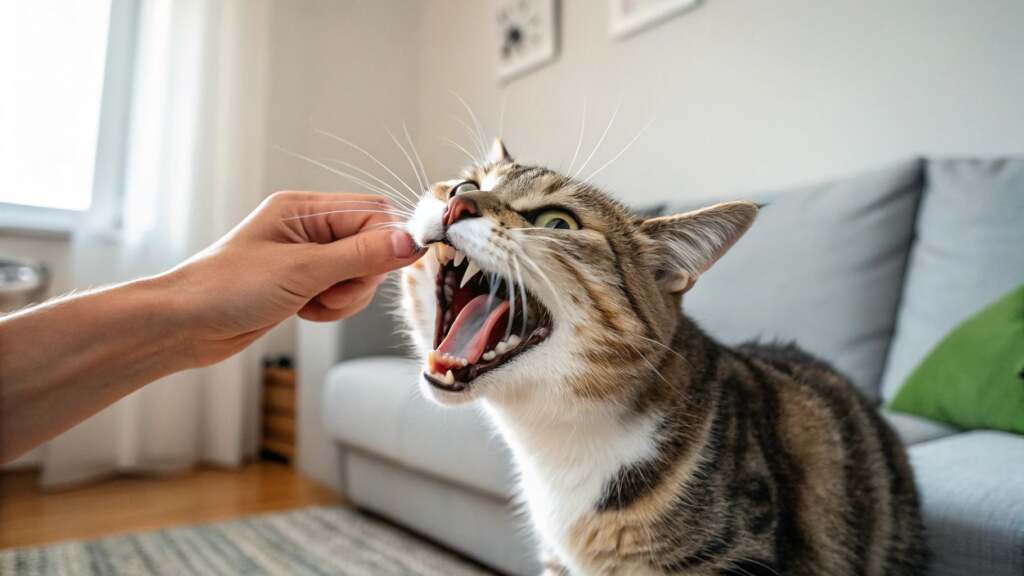If you’ve ever been calmly stroking your cat, enjoying a peaceful moment, only to be rewarded with a sudden nip or bite — you’re not alone.
This behavior leaves many cat owners confused, hurt (both physically and emotionally), and wondering what went wrong.
Is it a sign of aggression?
Is your cat mad at you?
Or is there something deeper at play?
The truth is, cats are far more complex than they seem, and that sudden bite isn’t necessarily about anger.
In this post, we’ll dive deep into why cats bite during petting, how to recognize the warning signs before it happens, and what you can do to prevent it — creating a more harmonious bond between you and your feline friend.
Understanding the “Love Bite” Phenomenon
First, let’s clear something up: not all bites are the same.
In many cases, a “love bite” isn’t about hostility — it’s about overstimulation.
Cats are sensitive creatures.
Their skin, especially around certain areas like the back, sides, and belly, contains a network of nerve endings.
When you pet them, especially for long periods or in sensitive spots, the sensation can go from pleasurable to overwhelming very quickly.
In essence:
What starts as enjoyment can suddenly become too much.
The bite is their way of saying,
“Hey, that’s enough now!”
Common Reasons Cats Bite During Petting
Let’s break it down further:
1. Overstimulation
As mentioned, repetitive petting can overwhelm your cat’s sensory system.
The longer or more intensely you pet, the more likely they are to reach a threshold where they must react.
Key signs of overstimulation before biting:
- Tail flicking or lashing
- Ears rotating backward or flattening
- Skin twitching along the back
- Restlessness or shifting position
- Sudden head turning toward your hand
If you notice any of these signs — stop petting immediately!
2. Sensitive Areas
Some cats are fine with strokes on the head, neck, and shoulders but dislike being touched on their belly, back, or paws.
If you unknowingly pet a sensitive area, even a normally affectionate cat might respond with a defensive bite.
Tip:
Observe where your cat enjoys being touched and respect their boundaries.
3. Control and Communication
Cats are independent by nature.
Sometimes, biting is a way for them to set the pace of the interaction.
It’s as if your cat is saying:
“I love you, but I’m done with this now.”
Unlike dogs, who may passively endure unwanted affection, cats are more assertive about ending interaction on their terms.
4. Redirected Aggression
If your cat is already agitated by something (another pet, an outside noise, etc.), they might redirect that frustration onto you during petting.
This kind of bite feels more intense and sudden, and the cat might seem visibly tense or alert before it happens.
Tip:
Always be aware of your cat’s environment during petting sessions.
5. Playfulness Misinterpreted
Young cats and kittens sometimes bite during petting because they are in a playful mood.
It’s not a warning — it’s an invitation to play!
The problem is, their “play bites” can still hurt.
Solution:
Redirect their energy onto toys instead of your hands.
How to Prevent Petting-Related Biting
Good news:
You don’t have to give up on cuddling your cat!
You just need to approach petting with more awareness and respect for their signals.
Here’s how:
1. Watch Body Language Closely
Cats are masters of subtlety.
Learn to recognize early signs of discomfort:
- Ears slightly back
- Quick tail movements
- Tension in the body
The earlier you notice, the quicker you can stop before a bite happens.
2. Keep Petting Sessions Short
Instead of long, intense sessions, opt for short bursts of affection.
This keeps the experience enjoyable and prevents overstimulation.
Think of it like this:
Better to end on a happy note than push them to irritation.
3. Respect Preferred Petting Zones
Most cats prefer being petted:
- On the top of the head
- Behind the ears
- Under the chin
Avoid:
- Belly
- Tail
- Feet (unless you have a super trusting cat!)
4. Use Positive Reinforcement
Reward calm behavior during petting with treats or gentle praise.
If they start showing early warning signs, stop calmly — don’t punish or yell.
Building trust takes patience.
5. Provide Alternative Outlets for Play and Energy
Cats who bite during petting may simply have excess energy.
Daily play sessions with toys like feather wands, laser pointers, or balls can burn off that playful aggression in a healthy way.
What NOT to Do When Your Cat Bites
- Don’t hit or yell.
This will only damage your relationship and make your cat fear you. - Don’t immediately resume petting.
Give your cat space to reset emotionally. - Don’t punish retroactively.
Cats don’t associate delayed punishment with past behavior.
Instead, focus on prevention and reading signals in the future.
Final Thoughts
Getting bitten during a petting session can feel confusing, even hurtful.
But when you understand the “why” behind it, it becomes clear that your cat isn’t being mean or spiteful — they’re just communicating the only way they know how.
By learning your cat’s limits, respecting their signals, and adjusting your approach, you can create a more positive, loving dynamic between you and your cat.
Remember:
Every cat is unique.
Some will tolerate long petting sessions.
Others may prefer short, gentle touches.
Learning your cat’s individual preferences is one of the most rewarding parts of being a cat parent.
And once you truly understand their communication, your bond will only deepen.
Has your cat ever given you a “love bite”? How did you react? Share your funny or surprising stories in the comments below!

